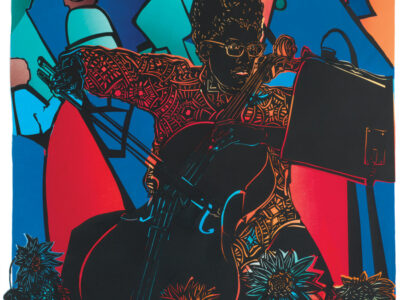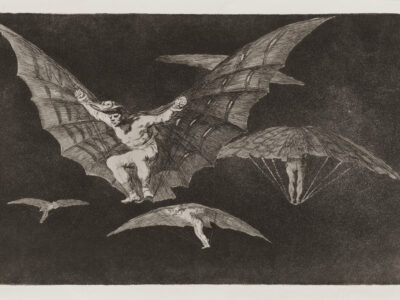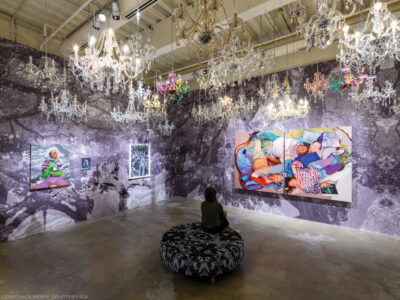A celebration of printmaking crosses all kinds of boundaries
By JoAnn Greco
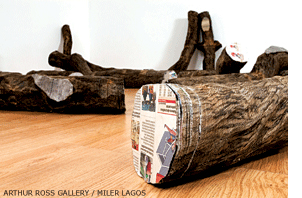
An illustrator whose whimsical creations have adorned The New Yorker comes to the usually edgy Institute of Contemporary Art. A Colombian sculptor who uses paper to comment on environmental and societal concerns settles into the stately confines of the Arthur Ross Gallery. And a multi-media provocateur whose installations explore the relationship between history, culture, and knowledge shakes things up at the Penn Museum.
What’s going on? The three artists are a few of the 300-plus who have taken over 80 venues citywide—including seven at Penn—to partake in Philagrafika 2010, which runs through April 11. Billed as one of the largest art events in the U.S., the festival celebrates the dynamic and under-appreciated role of printmaking in contemporary art. Five years in the making, Philagrafika is under the artistic direction of Jose Roca, a Colombian curator who grew to know Philadelphia while working on the ICA’s 2003 exhibition “Traces of Friday: art, tourism, displacement.”
It was Roca who suggested that the work of fellow Colombian Miler Lagos might make a good match for the Arthur Ross Gallery.
“This is the first time we’ve ever showcased a living artist,” said director Lynn Marsden-Atlass as she donned blue latex gloves to pitch in on the piece’s assembly. “We’re really excited about installing something that specifically relates to our space and to the University.”
Titled “Silence Dogood” (on view through March 21), the work gently references Benjamin Franklin and his role as a printer. While still a teenager, Franklin published a series of letters under the guise of a crotchety widow by that name, poking fun at, among other things, Harvard University.
Lagos’ methods of commentary are subtler—and more labor-intensive. He and four interns, along with a rotating crop of volunteers, spent three weeks crafting the work. Armed with glue sticks and endless patience, they patched together an ever-lengthening scroll made from two tons of old Philadelphia Inquirers and Daily Pennsylvanians. Using a contraption that he’d built from broomsticks and pipes, Lagos next hand-rolled the carpet of newspapers into a cylinder, seven feet in diameter, which he then singed so it would darken. Turned on its side, the cylinder is a realistic semblance of a tree’s cross-section.
“The newspaper is a cultural transmitter,” observes Lagos, “so it’s very impactful. It’s made of material which is fragile but which was once alive and strong. My work is about reversing the printing process, turning paper back into a ‘tree.’”
A “throne” made from stacked newspapers—a comment on the power of information, according to Marsden-Atlass—completes his installation.
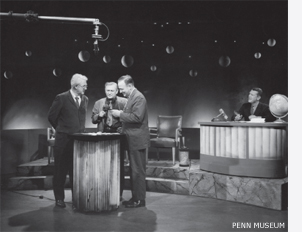
Over at the Penn Museum, another site-specific project holds court in a small third-floor gallery. “What in the World” (on view through April 11) is part of a Philagrafika component that pairs artists with Philadelphia’s historical collections and attempts to move beyond traditional notions of print. It uses the Museum’s 1950s television show of the same name as a jumping-off point. Pablo Helguera, a Mexican-born artist who currently works in the education department at New York’s Museum of Modern Art, says that while sifting through archival material at the Penn Museum he was “led to the individuals, the people associated with the University Museum whose colorful, eventful, and dramatic lives had a significant impact on the institution’s history.”
It’s these curators, donors, explorers, and collectors who give us a “glimpse into the institutional unconscious of the Museum,” Helguera continues. His resulting work is threefold: six video interviews of people associated with some of the Museum’s most dramatic stories, along with artifacts connected to those tales; a recreated set of the original “What in the World” program; and a companion book that will be published to document the project.

Although Maira Kalman’s “Various Illuminations (Of A Crazy World)” at the ICA is the most “traditional” of the major Philagrafika exhibits at Penn, it is also the only one that was scheduled independently of the festival, says Ingrid Schaffner, ICA’s senior curator. “It just seemed like a perfect fit. Maira is known for her New Yorker covers and her children’s books, but we really wanted to make this more of an installation, taking objects from her home and studio to create a marvelously detailed space.”
Strewn about are intimate symbols of domesticity—an old wooden ironing board; a pie chest filled with tea towels, lamps, and suitcases—that in their femininity and playfulness echo the graceful gouaches and colored pencil works that line the room. Awash in sky blues and salmon pinks, these 100 illustrations (as well as the textiles that Kalman has created for designers like Kate Spade and Issac Mizrahi) bring to mind everyone from James Thurber to Henri Matisse.
“I wake up, I go for a walk, I see something—and I put it into my work,” Kalman says. “I look around my home at objects that make me happy, like those on display, and I’m inspired. We are surrounded by image, type, product. So many things in our landscape are designed.”
JoAnn Greco is a Philadelphia-based writer.
Other Penn venues participating in Philagrafika include the PennDesign Alumni Association, the School of Design, the Rare Book and Manuscript Library, and International House. For a complete schedule, visit www.philagrafika2010.org.


